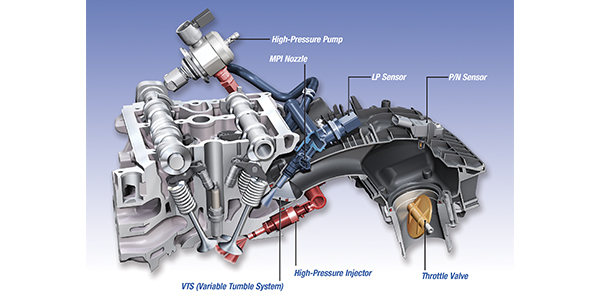Air Management Systems: Controlling Air From Throttle Body To Combustion Chamber
It is easy to manage fuel when compared to managing air. First, there is approximately 14 times more air than fuel in a running engine. Second, air reacts more to temperature and humidity than does fuel. Third, air can behave in strange ways under vacuum and pressure.

Tech Spec: 100 Years of Changing Internal Combustion Technology
It would be interesting to hear what Nicolaus Otto, credited as the father of the first functional four-stroke IC engine, would say after seeing some of the advanced powerplants dropped into vehicles today.
10 Signs A Fuel Injector Needs To Be Replaced
In the past 30 years, the fuel injector has moved from the intake manifold to the combustion chamber. During this evolution, injectors have become more precise in dispensing fuel. If this precision is thrown off by restrictions, electrical problems or fuel problems, it can cause driveability issues. These are the top 10 signs fuel injectors need service or replacement.
Diagnosing EGR And Secondary Air Systems
The perfect internal combustion vehicle would be able to put the exact amount of fuel and air into the combustion chamber. If the perfect combustion event happened, you would get nothing more than water and carbon dioxide. We are not there yet. In the mean time, we have exhaust gas recirculation systems (EGR), secondary air injection and catalytic converters.
Air Filter Fuel Trim Diagnostics
The modern engine measures two things extremely well, the amount of air going into the combustion chamber with the mass airflow sensor (MAF), and the byproducts that are generated by the combustion event with the oxygen sensor. These measurements allow the engine’s computer to put the right amount of fuel and spark into the cylinder to give the most efficient and cleanest combustion event.
How Does The EGR And Secondary Air Injection Work With The Catalytic Converter?
The perfect internal combustion vehicle would be able to put the exact amount of fuel and air into the combustion chamber. If the perfect combustion event happened, you would get nothing more than water and carbon dioxide. There would not be any unburned fuel or oxygen. What would be needed to make this happen? Direct injection into the combustion chamber is a good start. You would also need the perfect combustion chamber free from hot spots – areas of unwanted turbulence or carbon build up. In the mean time, we have exhaust gas recirculation systems (EGR), secondary air injection and catalytic converters to reduce emissions
Diesel Injection Components
One thing that has been discovered with diesel fuel injection is the higher the pressure at which it is injected creates more efficiency. The purpose of common rail injection is to deliver high-pressure fuel to the injector. Fuel in a common rail system will be injected into the combustion chamber through the injector nozzle at pressures as high as 28,000 psi. This is far from the mechanical systems of the past that would inject fuel into the combustion chamber at 2,000 to 3,000 psi.
Catalytic Converters: New Diagnostic Strategies
Catalytic converter failures on today’s vehicles are rarely caused by defects in catalytic converters. Most catalytic converter failures can be traced back to problems caused by what happens in the combustion chamber. Almost every part on the engine determines how long it will last. It could be a faulty line of computer code that pulses an injector too long, or it could be a stuck piston ring that allows oil to be sucked into the combustion chamber. These little details can limit the life of a catalytic converter.
Tech Tip: White Smoke Blowing From Tailpipe?
A classic sign of a head gasket problem is when the vehicle is blowing white smoke from the tailpipe. This indicates that water/coolant is entering the combustion chamber and is then burnt off as steam through the exhaust. The white “smoke” is water vapor as the steam condenses when it hits the colder atmosphere.
The Ins and Outs of Variable Valve Timing (VVT) Systems and Their Role in Vehicle Emissions
By the early 1990s, almost all import automotive manufacturers had a successful variable valve timing (VVT) system in production. These systems offered higher performance from smaller displacement engines at higher rpm. Do you know that VVT is playing a direct role in vehicle emissions and the way gases are burned in the combustion chamber?
